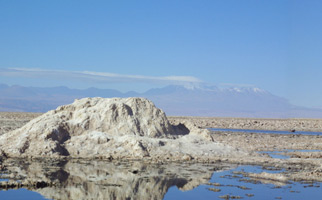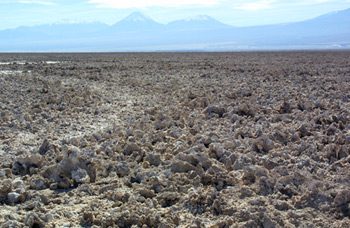




| Salar de Atacama | ||||||||||||
The Salar de Atacama, Chile´s largest salt deposit, lies about 40 miles (60 kilometers) to the south of San Pedro and occupies an area of over 6,000 square miles (about 15,620 square kilometers) at an altitude of greater than 7,500 feet (2,305 meters) above sea level. The Salar is a large salt flat located in an area that was once the southern shore of a vast inland sea. Many parts of the Salar are characterized by a rough, brittle white crust that crunches underfoot. The crust is formed by the constant accumulation of layers of salt crystals produced by the evaporation of subterranean waters with high saline content. The water rises through natural underground channels to a series of lagoons. The process of evaporation makes many shapes, with layers of rugged chlorides rising up to 30 inches (70 centimeters) in height, a transitional chloride layer forming polygonal structures, and a sulfuric layer originating in dry, flat areas. The Salar contains 40 percent of the world´s reserves of lithium, and also contains potassium, borax, and other salts. The sporadic lagoons that dot the surface of the Salar are fed by a great underground lake that, in turn, derives its waters from runoff from the Andes mountains to the east. Although salt flats are known to represent one of the greatest obstacles to plant and animal life on the planet, the Atacama lagoons provide a breeding ground for three types of flamingos and a habitat for other birds, such as Andean gulls, parinas, and ducks.
|

